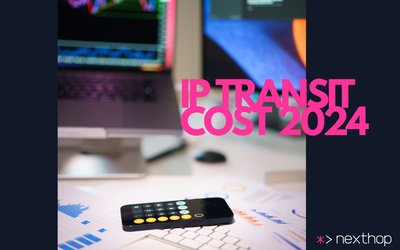Our blog
>
How does IP transit work?
IP Transit is a crucial concept that underpins the functioning of the internet as we know it. Put simply, IP Transit involves the exchange of Internet Protocol (IP) traffic between different Internet Service Providers (ISPs). This allows ISPs to connect with other networks and exchange traffic, enabling users to access websites and services across the internet. Known as "carrier-neutral transit" or "multihoming", IP Transit is an essential service that enables businesses and individuals alike to connect with others online. In this article, we will explore the concept of IP Transit in greater detail, examining its importance and exploring its potential applications for businesses and consumers.
What is IP transit?
IP Transit is the public exchange of Internet Protocol traffic between Internet Service Providers (ISPs). An IP Transit provider allows an ISP to connect to other networks and exchange traffic with them. This type of service is also sometimes called "carrier-neutral transit" or "multihoming".
How exactly IP transit works?
IP transit allows organisations to access larger networks and make the most of scalable, reliable, and cost-effective solutions. With an Autonomous System Number (ASN), IP transit providers use Border Gateway Protocol (BGP) to establish a direct connection between their network and the internet. This connection allows for fast failover in case of an outage on one link and provides continuity of service, making sure customer data is always secured with uninterrupted access.
Boost your network performance with our reliable IP transit service
Start your risk-free IP Transit trial today and get connected within 72 hours!
Sydney
/
Melbourne
/
Brisbane
/
Perth
Tiers Of IP Transit Providers
Tier 1 providers are companies that own their own network infrastructure, such as cable companies and telephone companies. They typically have a large network of customers and provide high-speed Internet access.
Tier 2 providers are companies that lease their network infrastructure from Tier 1 providers. They typically have a smaller network of customers and provide lower-speed Internet access.
Tier 3 providers are companies that lease their network infrastructure from both Tier 1 and Tier 2 providers. They typically have a very small network of customers and provide lower-speed Internet access.
IP Transit VS Peering
IP Transit and Peering are two different methods of exchanging data between networks. IP transit is the public exchange of Internet Protocol traffic between Internet Service Providers (ISPs). It allows an ISP to connect to other networks and exchange traffic with them, but does not guarantee low latency or high throughput. Peering on the other hand is a private agreement between ISPs where each will provide direct access to their network for the other. This leads to lower latency, higher throughput, and better overall performance than IP Transit. Peering also typically cost less than IP Transit services.
Role of IP transit in Your business
IP Transit serves several important functions for businesses. It allows them to easily connect to multiple networks and reach larger amounts of content and services from those networks. Furthermore, IP Transit helps ensure that any critical operations are always running smoothly even in the event of a network outage. Additionally, IP Transit can provide businesses with other features such as load balancing, route optimization, and traffic engineering which can help ensure their applications run reliably.
Why Nexthop IP Transit?
We offer our customers many benefits, including the premium blend service, which allows customers to aggregate traffic across multiple ports. This enables faster speeds and better performance for applications. Nexthop also provides dual stack IPv4 and IPv6 capabilities, allowing customers to take advantage of modern internet protocols. Furthermore, our flexible billing options make it easier for businesses to budget for their IP transit services. All these features make Nexthop the perfect choice for businesses looking for a reliable and cost-effective solution for IP transit. Contact us today to learn more about available options.






